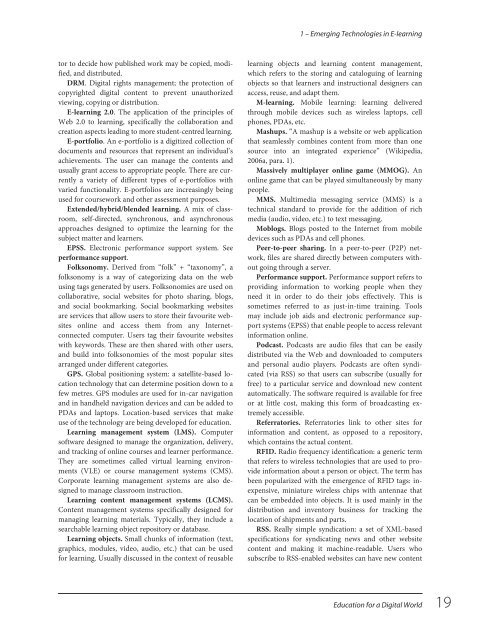Education for a Digital World Advice, Guidelines and Effective Practice from Around Globe, 2008a
Education for a Digital World Advice, Guidelines and Effective Practice from Around Globe, 2008a
Education for a Digital World Advice, Guidelines and Effective Practice from Around Globe, 2008a
You also want an ePaper? Increase the reach of your titles
YUMPU automatically turns print PDFs into web optimized ePapers that Google loves.
1 – Emerging Technologies in E-learning<br />
tor to decide how published work may be copied, modified,<br />
<strong>and</strong> distributed.<br />
DRM. <strong>Digital</strong> rights management; the protection of<br />
copyrighted digital content to prevent unauthorized<br />
viewing, copying or distribution.<br />
E-learning 2.0. The application of the principles of<br />
Web 2.0 to learning, specifically the collaboration <strong>and</strong><br />
creation aspects leading to more student-centred learning.<br />
E-portfolio. An e-portfolio is a digitized collection of<br />
documents <strong>and</strong> resources that represent an individual’s<br />
achievements. The user can manage the contents <strong>and</strong><br />
usually grant access to appropriate people. There are currently<br />
a variety of different types of e-portfolios with<br />
varied functionality. E-portfolios are increasingly being<br />
used <strong>for</strong> coursework <strong>and</strong> other assessment purposes.<br />
Extended/hybrid/blended learning. A mix of classroom,<br />
self-directed, synchronous, <strong>and</strong> asynchronous<br />
approaches designed to optimize the learning <strong>for</strong> the<br />
subject matter <strong>and</strong> learners.<br />
EPSS. Electronic per<strong>for</strong>mance support system. See<br />
per<strong>for</strong>mance support.<br />
Folksonomy. Derived <strong>from</strong> “folk” + “taxonomy”, a<br />
folksonomy is a way of categorizing data on the web<br />
using tags generated by users. Folksonomies are used on<br />
collaborative, social websites <strong>for</strong> photo sharing, blogs,<br />
<strong>and</strong> social bookmarking. Social bookmarking websites<br />
are services that allow users to store their favourite websites<br />
online <strong>and</strong> access them <strong>from</strong> any Internetconnected<br />
computer. Users tag their favourite websites<br />
with keywords. These are then shared with other users,<br />
<strong>and</strong> build into folksonomies of the most popular sites<br />
arranged under different categories.<br />
GPS. Global positioning system: a satellite-based location<br />
technology that can determine position down to a<br />
few metres. GPS modules are used <strong>for</strong> in-car navigation<br />
<strong>and</strong> in h<strong>and</strong>held navigation devices <strong>and</strong> can be added to<br />
PDAs <strong>and</strong> laptops. Location-based services that make<br />
use of the technology are being developed <strong>for</strong> education.<br />
Learning management system (LMS). Computer<br />
software designed to manage the organization, delivery,<br />
<strong>and</strong> tracking of online courses <strong>and</strong> learner per<strong>for</strong>mance.<br />
They are sometimes called virtual learning environments<br />
(VLE) or course management systems (CMS).<br />
Corporate learning management systems are also designed<br />
to manage classroom instruction.<br />
Learning content management systems (LCMS).<br />
Content management systems specifically designed <strong>for</strong><br />
managing learning materials. Typically, they include a<br />
searchable learning object repository or database.<br />
Learning objects. Small chunks of in<strong>for</strong>mation (text,<br />
graphics, modules, video, audio, etc.) that can be used<br />
<strong>for</strong> learning. Usually discussed in the context of reusable<br />
learning objects <strong>and</strong> learning content management,<br />
which refers to the storing <strong>and</strong> cataloguing of learning<br />
objects so that learners <strong>and</strong> instructional designers can<br />
access, reuse, <strong>and</strong> adapt them.<br />
M-learning. Mobile learning: learning delivered<br />
through mobile devices such as wireless laptops, cell<br />
phones, PDAs, etc.<br />
Mashups. “A mashup is a website or web application<br />
that seamlessly combines content <strong>from</strong> more than one<br />
source into an integrated experience” (Wikipedia,<br />
2006a, para. 1).<br />
Massively multiplayer online game (MMOG). An<br />
online game that can be played simultaneously by many<br />
people.<br />
MMS. Multimedia messaging service (MMS) is a<br />
technical st<strong>and</strong>ard to provide <strong>for</strong> the addition of rich<br />
media (audio, video, etc.) to text messaging.<br />
Moblogs. Blogs posted to the Internet <strong>from</strong> mobile<br />
devices such as PDAs <strong>and</strong> cell phones.<br />
Peer-to-peer sharing. In a peer-to-peer (P2P) network,<br />
files are shared directly between computers without<br />
going through a server.<br />
Per<strong>for</strong>mance support. Per<strong>for</strong>mance support refers to<br />
providing in<strong>for</strong>mation to working people when they<br />
need it in order to do their jobs effectively. This is<br />
sometimes referred to as just-in-time training. Tools<br />
may include job aids <strong>and</strong> electronic per<strong>for</strong>mance support<br />
systems (EPSS) that enable people to access relevant<br />
in<strong>for</strong>mation online.<br />
Podcast. Podcasts are audio files that can be easily<br />
distributed via the Web <strong>and</strong> downloaded to computers<br />
<strong>and</strong> personal audio players. Podcasts are often syndicated<br />
(via RSS) so that users can subscribe (usually <strong>for</strong><br />
free) to a particular service <strong>and</strong> download new content<br />
automatically. The software required is available <strong>for</strong> free<br />
or at little cost, making this <strong>for</strong>m of broadcasting extremely<br />
accessible.<br />
Referratories. Referratories link to other sites <strong>for</strong><br />
in<strong>for</strong>mation <strong>and</strong> content, as opposed to a repository,<br />
which contains the actual content.<br />
RFID. Radio frequency identification: a generic term<br />
that refers to wireless technologies that are used to provide<br />
in<strong>for</strong>mation about a person or object. The term has<br />
been popularized with the emergence of RFID tags: inexpensive,<br />
miniature wireless chips with antennae that<br />
can be embedded into objects. It is used mainly in the<br />
distribution <strong>and</strong> inventory business <strong>for</strong> tracking the<br />
location of shipments <strong>and</strong> parts.<br />
RSS. Really simple syndication: a set of XML-based<br />
specifications <strong>for</strong> syndicating news <strong>and</strong> other website<br />
content <strong>and</strong> making it machine-readable. Users who<br />
subscribe to RSS-enabled websites can have new content<br />
<strong>Education</strong> <strong>for</strong> a <strong>Digital</strong> <strong>World</strong> 19


















